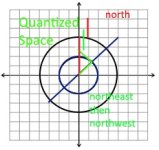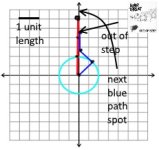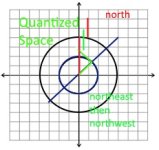Quantized means to actually have existence.
Quantized, in the context of this conversation, means discontinuous or discrete.
Imagine that spacetime is 2 dimensional, direction is quantized in such a way that you can only go in 8 directions. Length is also quantized, so you can only go multiples of the fundamental length.
Take 2 particles. Move particle A north 1 fundamental unit from an origination point, move particle B northeast 1 unit from the origination point. There is no way that particle B would ever be able to run into particle A again, unless particle A somehow went northeast, or particle B went southwest 1 unit.
You know why? Moving 1 unit to the northeast means that particle B moved 1/sqrt(2) north, and 1/sqrt(2) east, while particle A went 1 unit north. There is no way that an integer multiple of 1/sqrt(2), other than 0, will ever fall on an integer value. The particles will never intersect.
Only if direction or length of spacetime are non-quantized, can you have particles or fields that intersect/interact equally with one another.
If either direction or length are non-quantized, there are inherent infinities built into the structure of spacetime (and the universe as a whole). Not only that, but the color blue exists as well.
Sorry to interject here but I disagree somewhat with your analysis here.
I agree with you that if both direction and length are fundamental things and quantified there's an impossibility. However, we can think of quantified space in a very different way.
Quantified space can be understood as a collection of discrete locations neighbouring or not neighbouring each other. Particles can only move directly from one location to any of the neighbour locations. And that's it. The two notions of length and direction can be thought of as only secondary, i.e. not fundamental.
So for example, a two-dimensional space could look like a chess board where two locations on the board are neighbours either only if they have a side in common or if they either have a side or a corner in common. In the first case, particles could be thought of as Towers only able to move from one square to another if the two squares have one side in common, which would result in each Tower having always four possible directions of movement, say, North, South, West and East (assuming the board itself would have no limiting sides). The shortest distance that a Tower could cover in this case would always be exactly 1, i.e. one location to one of the four neighbour locations).
If the second case, particles could be thought of as Queens, able to move between two squares if they have a side or a corner in common. Particles like this could always access eight possible directions, moving like Queens on a chessboard in straight lines from one location to the next.
In this case, however, the question of the distance covered is a bit more complicated because there are two basic models. One says that the distance covered from one location to the next is always 1 irrespective of whether it's done through a side or a corner. So, here, distances are quantified as multiples of 1. The other model would say that the distance covered is 1 in the case of a side move and square root of 2 in the case of a corner move. So, here, distances would be quantified as multiples of 1 or as multiples of square root of 2. No big deal since distances would be only secondary properties.
In either case, the space considered could be infinite, for example if its geometry is flat and without 'board sides', or finite, for example if the geometry is a closed one, like that of a cube for example, or if the space is limited by borders.
In other words, it is not necessary to import into your model of quantified space the particular topology of our ordinary continuous space, where distances are thought of as fundamental and broadly determined by a straightforward Pythagorean relation (square root of x square plus y square plus z square). You can conceive of distance relations in a wide variety of guises as long as they comply with the axiomatic definition of distance: Reflexivity: d(A,A) = 0; Symmetry: d(A, B) = d(B, A); Triangular inequality: d(A, B) + d(B, C) >= d(A, C).
This opens up possibilities a great deal, which only UM will inevitably complain about.
Lovely weather right now over Paris.
I'm getting emotional these days.
EB




